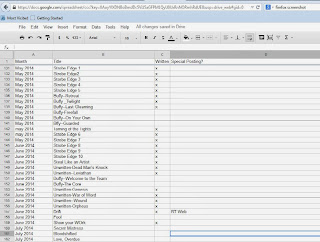A class hub can make all the difference for digital writing and learning! ![]()
Viewing: Blog Posts Tagged with: Organization, Most Recent at Top [Help]
Results 1 - 25 of 128
Blog: TWO WRITING TEACHERS (Login to Add to MyJacketFlap)
JacketFlap tags: blogging, authors, organization, professional development, communication, writing workshop, parent involvement, preparing students for the 21st century, apps, digital writing, kidblog, #cyberPD, Cathy Mere, Flipping writing, Add a tag
Blog: TWO WRITING TEACHERS (Login to Add to MyJacketFlap)
JacketFlap tags: classroom environment, writing workshop routines, environment, organization, materials, partnerships, routines, first day, procedures, Add a tag
Have you ever visited a colleague’s classroom or watched a video of a lesson and wondered, “How are those kids so perfect? How do they seem to know exactly what to do, the… Continue reading ![]()
Blog: Valerie Storey, Writing at Dava Books (Login to Add to MyJacketFlap)
JacketFlap tags: Writing, Organization, Add a tag
Writing a series of poems based on my trip to Taiwan last year wasn't on my 2016 to-do list. It really wasn't, but now that it's appeared, I can happily say I've battled through and my first draft is well and truly finished. Yay!
That said, it wasn't an easy journey, especially when I reached a place several weeks ago where I was well and truly stuck: right smack dab in the middle. I was uninspired, tired, and beginning to worry that the whole project was a major distraction and a waste of time.
Reaching the middle of any project rarely feels like a victory. Instead, all I can usually think of is how much more work I have to do to finish. So when I found myself in the middle of A Taiwan Sketchbook (my working title) rather than writing the second draft of my new novel, Ghazal, I suddenly realized how long it had taken me to get to where I was, and how much more effort I had to put into the project before I could type THE END. Just thinking about all those hours of work ahead of me sent me to the couch and a headache.
While I was lying there, feeling both guilty and utterly defeated, I thought of all the stages of my project that had brought me to where I was, starting with my GRAND IDEA:
- The excitement of STARTING. It was so much fun. I love starting new projects. All that anticipation, planning, preparing new notebooks and buying new pens. Nothing better!
- Once all my tools were in place, the next stage centered around starting new rituals, new schedules, new dedication--writing every day, staying on track, marking my progress on a calendar.
- And then . . . I had to skip a day. An appointment, having to stay late at work, no food in the house . . .
- So I had to put in double-duty the next time I sat down to write to make up for lost time.
- Which meant: this is starting to feel like WORK. Where'd the fun go?
- Before I knew it, I was in the MIDDLE of a project and it all seemed like chaos and hell and something that would take me the rest of my life to complete, if I ever survived to tell the tale.
- Give up--yes! At least for the moment. Stay on the couch, read, watch a movie, take a break. If you really have reached the middle of your work, you deserve a little time off!
- When you feel rested, start back at the beginning when you got those nice writing supplies. Organize what you have already accomplished into new folders and binders; brainstorm and create lists of what you need to do to finish.
- Forget about order and following an outline. Write the scenes or portions of your work you want to write, don't worry about transitions or a table of contents.
- Concentrate on your ending first. Write your last scene (or poem, or paragraph depending on what it is you're working on) and craft the rest of your story to fit your conclusion or theme.
- Calculate how much time it took you to reach the middle. Now assign that same amount of time, plus an extra few weeks or so for emergencies, and give yourself a deadline. Write it down on a calendar.
- Work fast. Remember this is first draft stuff. Just get there--it doesn't matter how!
Tip of the Day: Stuck in the middle of your WIP? Brainstorm! Create a list of 100 new "what-if's" and scenes. See which ones can inject fresh energy into your manuscript. And always keep in mind, once you've passed "the middle," it's all downhill from there!
Blog: Here in the Bonny Glen (Login to Add to MyJacketFlap)
JacketFlap tags: Organization, Evernote, Mystie Winckler, Add a tag
Heads up: Mystie Winckler’s free Evernote e-course starts today!
I really enjoyed Mystie’s Simplified Organization and Simplified Pantry courses. She’s kind of an Evernote genius.
Add a CommentBlog: Here in the Bonny Glen (Login to Add to MyJacketFlap)
JacketFlap tags: Organization, moleskine, sketchbook, fountain pens, planning, Household, planners, Nerd, Midori, Lesley Austin, Paper & Desk, Homeschool Record-Keeping, travelers notebook, Lamy, Add a tag
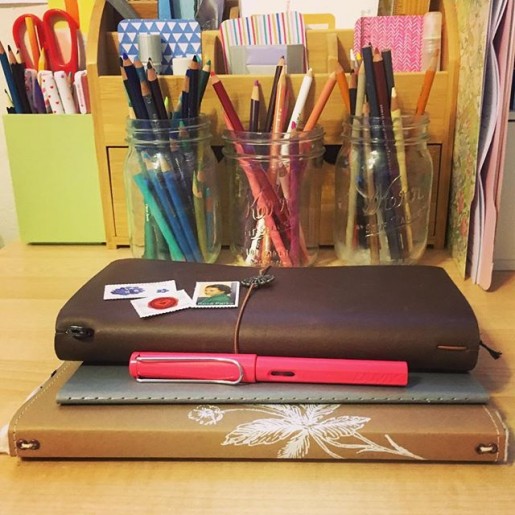
My everyday favorites. After a year of experimenting, I’ve got my system figured out. Top to bottom:
• Midori Travelers Notebook for my monthly calendar, weekly journal, and a scribble notebook;
• Moleskine Cahier for daily to-lists (bullet journal);
• Wild Simplicity Daybook for homeschooling notes and records (including our weekly Shakespeare lines—we learn monologues two lines at a time); and
• the Lamy Safari fountain pen my family gave me for my birthday. (LOVE.) (That’s an Amazon affiliate link but if you’re buying pens in the U.S., you should order from the nice people at Goulet Pen Company. Their instructional videos are invaluable, their customer service is top notch, and they offer inexpensive ink samples so you can try out all sorts of gorgeous colors. And that is not an affiliate link. I’m just a happy customer.)
I still keep the family appointments on Google Calendar, but I enjoy writing everything out in the TN monthly calendar (#017) as well. I use the horizontal weekly TN insert (#019) for chronicling the day after it happens—just a few notes about highlights. For the last several months I’ve used a blank TN insert (#003) for my bullet journal but came to realize I need a separate space for scrawling, sketching, doodling, working things out on paper. If I do that in the bullet, things get messy. WAY messy. So I’ve gone back to my old (cheaper) Moleskine grids for task lists.
The Midori travels with me everywhere; the bullet journal lives on my desk where I do most of my work; and the Daybook has a home in a basket by my rocking chair in the living room.
I’m laughing at how complicated this must seem if you aren’t a pen-and-paper fanatic…but I juggle a lot of roles (and kids) and I find having different paper spaces helps me keep things straight.
More nitty gritty:
I also have a kraft folder (#020) in my Midori to tuck ephemera and snail-mail supplies into. Since I started carrying notecards and stamps around, I’ve gotten much more prompt with my thank-you notes.
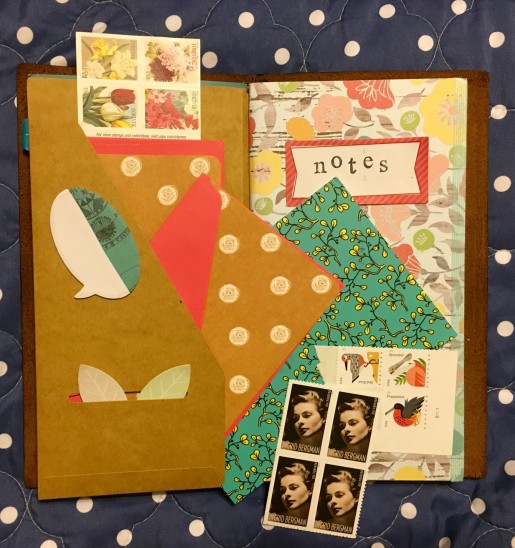
• I love the feel of Prismacolor colored pencils on the paper Lesley Austin uses in the Wild Simplicity Daybook. I’m sure I’ve raved about this before—the lovely creamy pencil on this recycled paper with just the right amount of tooth.
• Prismacolor pencils also delight me in the bullet journal: I like ’em for filling in my checkboxes.
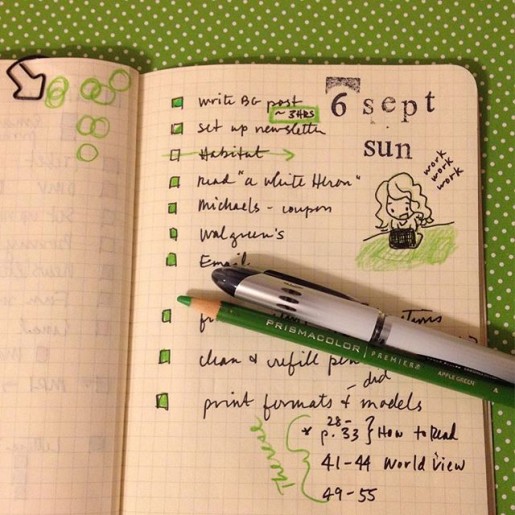
• This pic, which I’ve shared here before, shows my favorite way to organize a task list: to-do items on the right, and the verso is for related notes and numbers. I also keep a running “Nag List” on a sticky note that travels from spread to spread. It’s for important tasks that I might not get done today but I gotta deal with soon—like finishing my taxes or booking a doctor appointment. I consult it each evening when making out my bullet list for the next day.
• Sometimes I’ll tuck another insert into the Midori to be used for a specific purpose. For example, I keep a log of incoming and outgoing snail mail. I don’t like a superfat Midori, though, so more often that insert lives in my stationery pouch.
• As I mentioned, I do a lot of casual sketching in my blank Midori insert. I find I’m often more comfortable there than in my proper sketchbook, because it feels more casual. But I do have a couple of sketchbooks going and I try to work in at least one of them daily. One is a spiral-bound 7×10 Canson Mixed Media pad, which gets lukewarm reviews from real artists but I quite like its toothy paper—not to mention its price point when Michael’s has a good sale + coupon combo. You have to watch for it, but now and then they’ll give you a 20% off including sale items coupon during a buy-one-get-one-free sketchbook sale. My other sketchbook is a Moleskine Art Plus, and it’s…okay? I love its size and shape (fits nicely in my bag), but the paper is too smooth for my liking. I much prefer the feel of Moleskine’s watercolor sketchbook—a lovely texture to that paper. But so far I’ve mostly just used that for color charts.
• For sketching pens, I like Sakura Pigma Microns or my Pilot Metropolitan fountain pen (check out all the groovy colors at Goulet Pens) with Platinum Carbon ink, which is waterproof so it plays nice under watercolors. However, lately I’ve come to realize that what I enjoy most of all is sketching in pencil. I love the look of black or brown ink drawings, and most of the sketchbook artists I admire work directly in ink, but I really love the way a pencil feels on the paper. I keep hitting that point over and over, don’t I—the tactile experience matters more to me than how it looks.
Ha, this got long! Would you believe it was just going to be a quick copy-paste of something I tossed on Instagram today?
Add a CommentBlog: So Many Books (Login to Add to MyJacketFlap)
JacketFlap tags: Books, Reading, organization, online reading, time time I need more time, Add a tag
So here’s a question for you because I am always curious about how readers organize their reading and their time. We all read books but I know, if you are reading this, you also spend time on the interwebs and you probably spend time reading blogs but I also know you spend time reading other things online too. At least I am assuming you do because I know I do. I’m not talking about news, but longer stuff. Let’s call it long-from internet writing whether it is a long book review essay at the Los Angeles Review of Books (if you don’t read LARB by the way you are missing out I actually tend to like them better than NYRB because they have more variety and are less pretentious and know the world does not revolve around New York or Los Angeles) or maybe an article at Slate or The New Yorker or Bicycle Magazine or any number of the many places you like to visit on your internet rounds.
I’m going to bet that you are also like me in that you often find interesting long-form writing but gosh darn, just don’t have the time or brain power when you come upon it to read it right then and there. So you save it for later.
First question: Where/How do you save your read laters?
Since I am asking you, I will reciprocate and tell you that if something comes up in my feed reader (Feedly) I will save it for later there. I have a Mac and use the Safari browser that has a handy “read it later” feature where it will save articles in the browser but not as bookmarks. It’s hard to explain, but it is a useful feature for anything I come across through channels other than my feed reader. I have tried other methods like Delicious and Reddit but those are so out-of-sight, out-of-mind that I forget about them. Plus, no offense, but I really don’t care about the social aspects of those sites — what everyone else is reading, nor am I particularly interested in sharing what I am reading (or saving for later as the case may be).
Inevitably, the number of items I save for later pile up because I never have enough time later to catch up with them all. Just like books piling up on my reading table, I think I have more time and opportunity to read everything I want to read than I actually do.
Second question: What do you do with all your saved for later reading when you realize that later is not going to come?
Sometimes I might unsave an article or two but most of the time when I scan my lists I still want to read what I have saved so I end up hardly ever deleting anything unless I actually read it which, as I mentioned, is not as often as I expect. And then of course the saved things end up becoming a big, unwieldy mess. When that happens I am tempted to just delete it all and start fresh but then I see all kinds of things I still want to read and, well, you can guess what happens then, or doesn’t happen is more like it.
Eventually, like now, I start to feel overwhelmed by it all and I hold extensive debates with myself over what I should do. Before I allow myself to get sucked into another one my pointless internal debates, I thought I would ask you my two questions. So lay it on me, share your wisdom. How do you manage it all? Or maybe, like me, you don’t, and that’s okay too. I’ll be happy to know that I have company.
Filed under: Books, Reading Tagged: online reading, organization, time time I need more time
Blog: TWO WRITING TEACHERS (Login to Add to MyJacketFlap)
JacketFlap tags: materials, student work, organization, Add a tag
Are you feeling inundated with paper in your writing workshop? Here are some quick tips to help you help your students organize their writing so that their desks and writing folders are less cluttered.![]()
Blog: The Renegade Writer (Login to Add to MyJacketFlap)
JacketFlap tags: Writing, Motivation, Advice, Organization, Money, time management, freelance writing, productivity, 4 hour work week, 4 hour workweek, how to earn more as a writer, how to work less, work less, Add a tag
 In 2009, I started researching and experimenting with ways to work less and earn more with my writing. I started out by vowing to work only two days per week.
In 2009, I started researching and experimenting with ways to work less and earn more with my writing. I started out by vowing to work only two days per week.
It worked — and I’ll tell you how in a bit.
Since 2009, my schedule has settled to 30 hours per week or less; more than before because now my son is in school all day, and I really do love what I do and find it hard to keep myself from writing. These days, I generally work from 9-2:30 daily, and often take Fridays off if I can.
And during it all, my freelancing income has gone up by 30%.
Want to know how I did it? Let’s start in 2009.
How I Cut My Work Hours & Still Kept Earning
My goal, when I started the two-day workweek in 2009, was to spend more time with my one-year-old son, have more fun, and do more volunteering. On my days off I would check e-mail just to make sure nothing came up, and if a source could schedule an interview only on one of my days off, I’d do it. But most weeks, I sat down at my desk and worked two days per week.
The first thing I did to cut my hours was quit a time-suck writer’s forum. I could spend hours on there every day because there were so many members that every time I clicked, there was a new message. One day I posted a question about freelancing, and was treated to snarky responses about how I should already know the answer.
Right then, I decided to quit. I had my husband change my password and promise not to reveal it to me. For a couple of days my fingers kept twitching towards the keys that would bring up the forum, but then the urge subsided.
Then, on a roll, I found a free site-blocker app and blocked the other sites I spent a lot of time on, like iCanHasCheezburger.com and Failblog.
Suddenly, I had a ton of free time.
I soon came to realize that a lot of what we freelancers do is busy work. For example, I was in the habit of sending out e-mails to sources or editors in the morning, and then spending the rest of the day alternately clicking on “check e-mail” and surfing the web. Then, at 5, I felt that I’d put in a full day’s work, even though I really only worked for a few minutes and then spent the rest of the day waiting for people to get back to me.
So I stopped doing that. If I sent out e-mails and couldn’t take action until I got a response, I would shut my laptop, go off and do what I wanted to do, and come back later to check. Exact same results, but much less time “working.”
One week I felt stressed about all I had to do: I had several writing assignments on the go and was insistent on working three days that week at the most to get it all done. I asked my life coach for tips, and she said that many of her clients feel they have too much to do, but then when they sit down and actually calculate the hours — or actually do the work — they realize it’s not so much after all. They had just built it up in their minds.
So my goal buddy and I set up what we called a “boot camp” day on one of my work days that week. On boot camp days, my Jennifer and I called each other every hour on the hour to tell each other what we did in the last hour and what we planned to do in the next hour. There were no repercussions if we don’t get the work done, but there’s something about telling someone else what you plan to do that lights a fire under your butt.
And guess what? That day, I got all the work I had been worrying about done in four hours. I didn’t even have to work that third day.
You CAN Set Your Own Hours
Those were some very, very valuable lessons, and after so many years of freelancing, I’ve really realized the full power of the freelance lifestyle — the power to set your own hours and be the master of your own time.
The eight-hour workday is so ingrained in us that it’s hard to envision working less and still earning the same income — but as Tim Ferriss said in The Four-Hour Workweek, isn’t it amazing that all over the world, no matter what job they do, every person needs exactly eight hours a day to get their work done?
We freelancers are not in jobs where we have to be present all the time, like in retail. We can “disappear” and, using the power of technology, still be reachable if a client has an emergency (which they rarely do).
Granted, when I started cutting my hours in 2009 I had already been freelancing for 12 years, so I was past the stage where I had to spend hours each week formulating ideas and pitching. I was in many magazines’ “stables” of writers, so it was easier for me to cut down my hours than it would be for someone just starting out.
But even new writers can probably use their time more efficiently. C’mon, fess up — when you should be writing a query or building your website or working on a book chapter, are you 100% focused on that task or are you taking frequent web-surfing breaks? Do you bang out that pitch or do you procrastinate, yet still feel “busy” because you’re sitting in front of your computer?
Do MORE of What You Love
So what did I do with all this extra time in 2009? Well, I started a local parents’ group that ended up with over 100 members, so I spent a lot of time hanging out with other parents and their babies. I read — a lot. I upped my weight training from two days per week to three. And I did more volunteering for animal welfare causes.
Isn’t that why so many of us decide to go freelance — so we can control our workloads and our hours, and have more time to spend on our families, hobbies, and causes?
Every day I have to pinch myself — I can’t believe that so many years later, I’m still working reduced hours and earning more than ever. I keep thinking that one day, my husband is going to say, “Uh, Linda…we’re broke.” But it hasn’t happened. I’m going to keep up this schedule as long as I can…and the more I do it, the easier it gets.
Your challenge today: Want to work less and earn more as a freelance writer? Find your top five time-wasting activities and find ways to ditch or delegate them.
This post originally ran in 2010 and has been updated to be more helpful to you.
Add a CommentBlog: Here in the Bonny Glen (Login to Add to MyJacketFlap)
JacketFlap tags: Organization, Day Planners, planners, Midori, things that make me swoon, Lesley Austin, Small Meadow Press, Paper & Desk, Daybooks, Add a tag
As a member of Wisteria & Sunshine, Lesley Austin’s gentle online community for home-and-hearth inspiration, I’ve had the fun of watching behind the scenes as her beautiful new Wild Simplicity Daybook took shape. Today is a day to celebrate, because the Daybook has landed in her Etsy shop!

It’s a Midori-style cover made with the tender eco-friendly consciousness that suffuses all Lesley’s handmade wares, and she has created a selection of inserts to let you customize your Daybook for your own use. I’m particularly fond of Lesley’s monthly calendars (I’ve been using them in one form or another for almost a decade!), and her new weekly diary pages are the loveliest I’ve seen anywhere. She offers them in insert booklets spanning three months at a time, with the Autumn and Winter inserts currently available.
Besides the monthly and weekly calendar inserts, she is also offering blank inserts for notes or journaling and a “Days to Keep” booklet for recording birthdays, anniversaries, and other special dates.
This probably sounds like a sponsored post, but it isn’t! And Lesley didn’t ask me to write it. I am a longtime fan of her paper goods who has had the pleasure of becoming Lesley’s friend as well, and I’m so excited to see her latest venture take flight. Recently I was chatting with another friend about things we love, and I said, “I think my aesthetic is one part Waldorf kindergarten, one part library, and one part Small Meadow Press.” 
Blog: ALSC Blog (Login to Add to MyJacketFlap)
JacketFlap tags: organization, goals, Summer Reading, back to school, Early Literacy, Blogger Meg Smith, Add a tag
With our summer reading club winding down tomorrow, August 15th, now seems like a perfect time for us to focus on some new goals as kids return to the classrooms. What ideas do you have to improve your programs, services, and library spaces during this next school year?
Out with the Old
During our busy summer it can be nearly impossible for us to organize everything we need as we scramble from one program to the next. It may not appear as exciting as some of our other tasks, but organizing our offices and closets during this time of transition after summer reading and before the school groups come rolling in can prove tremendously helpful. We complete an inventory of our closets and find some previously hidden treasures that could work perfectly as a prop for story time or an innovative craft. This also helps us save a lot of time when we have things better organized so we can best access our materials, and we use this time to order more supplies to ensure our closets are better stocked when we have those last minute programs we need to put together. Are there any special projects you are taking on to ensure your work space is better organized moving forward this school year?
Examining Our Early Literacy Efforts
Our focus this fall is to streamline our efforts with our early literacy programs and services. Our December youth services training will review the latest edition of Every Child Ready to Read to ensure our new staffers have the skills and confidence to encourage parents and caregivers to participate in early literacy activities with their children at home. We will examine the agencies already available in our community to determine how they provide programs and resources to our children and their families. It is important for us to consider how to reach out to the customers walking through our doors as well as the day cares, preschools, and hospitals we may partner with in order for us to better serve our patrons. What projects or goals do you have to improve your services to your customers as we transition into this new school year?
Summer Reading Brainstorming
As soon as we complete one year’s club, we begin to focus on the next. The ALSC Blog has been a valuable resource for us as we read the creative ideas from librarians across the county interested in innovative ways to increase participation and get children excited about reading all summer long. We will review our prizes and programs to consider how to best reach our audiences next year. When we give our summer reading program the emphasis it deserves by debriefing our previous program and planning the next early in the year, we work to ensure our next year’s program is as successful as possible. It may seem light years away from now, but June and the start of our next summer reading club will be here before we know it. What ideas do you have to enhance your summer reading program for next year?
August is a month full of transitions from one busy season to the next. We will focus our efforts on decluttering our spaces, enhancing our early literacy efforts, and beginning our initial planning for next summer’s reading program. What plans and ideas do you hope to complete during this new school year? Please share in the comments below!
The post A Fresh Start for the New School Year appeared first on ALSC Blog.
Blog: Here in the Bonny Glen (Login to Add to MyJacketFlap)
JacketFlap tags: organization, homeschool, Household, Paper & Desk, Homeschool Record-Keeping, listmaking, record-keeping, task management, WorkFlowy, Add a tag
This is one of those posts that will likely only appeal to a few of you, but I thought it might be useful info for some. I’ve been test-driving a task management app called WorkFlowy this week. So far, so great, I gotta say.
I’ve mentioned before that I move back and forth between listkeeping and planning on paper and on the computer, sometimes tilted more one way than the other. I love my kraft-brown Moleskine Cahier grid journals for daily notes and bullet lists (and a whole lot of doodling), and I don’t see myself ever giving up paper altogether. Especially since I started putting an index on the first page, a la the bullet-journaling method. That simple step made instant coherence out of my mishmash of notes. I refer back to old notebooks frequently and now I can find the thing I’m looking for with relative ease.
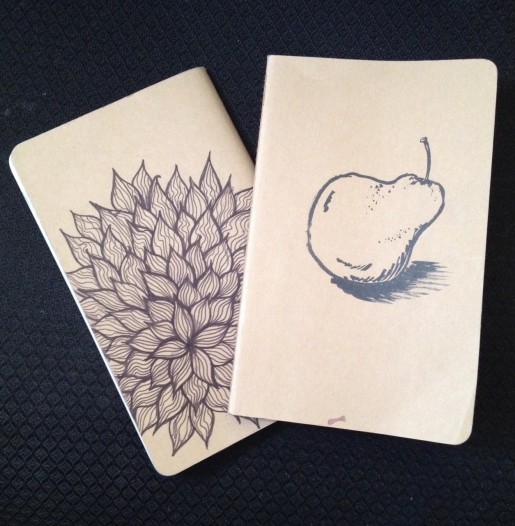
So why do I use an online task list too? Isn’t that overkill? Not really, not the way I work. I need paper notebooks for a dumping ground, but the computer helps me stay streamlined and focused. For a long while, I was using a combo of Evernote and Remember the Milk (a to-do list app, quite a good one), as described in Mystie Winckler’s Paperless Home Organization. I still stash a lot of stuff in Evernote, but somewhere along the line I fell away from using RtM.
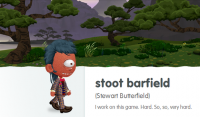 WorkFlowy caught my attention when I read that Stewart Butterfield’s team used it while building Slack. (I’m laughing at what a geek that sentence reveals me to be.) Stewart shall forever be known to us former and devoted Glitch players as Stoot Barfield. Before Glitch, he co-founded Flickr. Innovative guy. Slack has become my platform of choice for IM conversation with Scott and one or two other close friends I chat with often during the day. But that’s a topic for another post.
WorkFlowy caught my attention when I read that Stewart Butterfield’s team used it while building Slack. (I’m laughing at what a geek that sentence reveals me to be.) Stewart shall forever be known to us former and devoted Glitch players as Stoot Barfield. Before Glitch, he co-founded Flickr. Innovative guy. Slack has become my platform of choice for IM conversation with Scott and one or two other close friends I chat with often during the day. But that’s a topic for another post.
Anyway, I read about WorkFlowy and had to check it out for myself. It’s a streamlined, basic listmaking platform—and it’s marvelous.
It isn’t flashy. Just a simple list of bullet points in outline form, black text on a white screen. (There are a few other theme options, but none of them appeal to me.) You indent your bullets with the tab key, creating as many tiers as you like.
Here’s my basic list, collapsed so you only see the main topic categories.
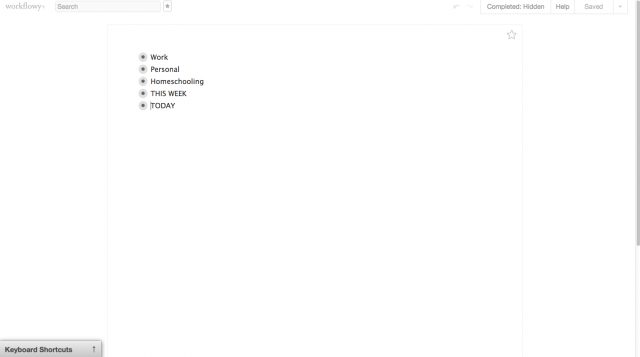
This image shows you my whole Workflowy tab because I wanted to show how uncluttered the interface is. I’ll crop the rest of my pictures so you can see the list up close.
Those are the five top-level categories I created, for now. (Remember, this is my first week with it.) “Work” and “Personal” are the top-level categories the tutorial suggests at the outset, and they seemed a good fit for me.
The grey circles around the bullet points mean there are entries under each one. Above is the collapsed view, hiding the rest of my outline. Let’s click to expand something.
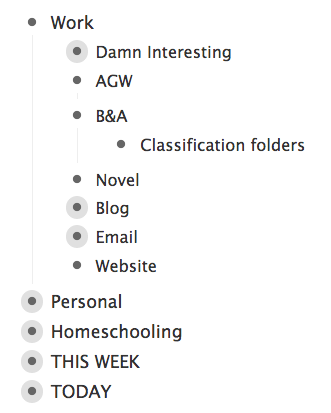
Here I’ve expanded the Work item, revealing various work subcategories I have created. My freelance clients, the novel I’m revising, and so on. I stuck my blog under work because it’s related to writing or editing, just like everything else on this section of the list.
So far, Personal is divided into subcategories like this:
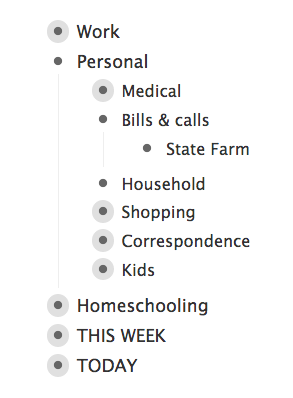
Under “Kids,” I have subcategories for each kid. (Workflowy calls them “children,” by the way—the subcategories, I mean, not my offspring. The top-level bullets are “parents.”) I’m finding this section particularly useful, a place to record who needs new shoes or has an activity coming up. It does have a bit of overlap with my Medical, Homeschooling, and Shopping categories, so as time goes on I may find I prefer to combine some of my sections.
You hover the mouse to the left of the bullet to pop up the collapse/expand option. Hovering over the bullet itself gives you a chance to mark the item complete, add a note, or other do other things with it, as you see in the popup.
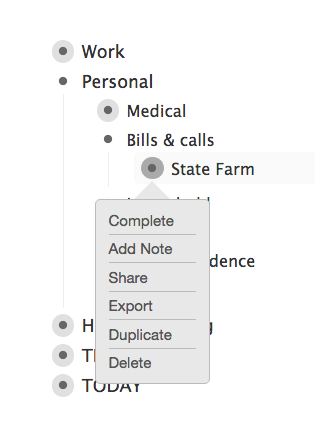
If you click on a bullet point, the switch to a view of just that one parent category and its children. Like this, when I click on the bullet next to “Homeschooling.”
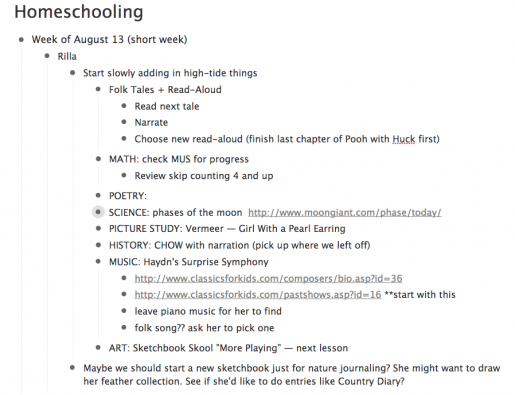
And here you see where I began to fall in love with Workflowy. It allows me to keep everything in one place—plans, lists, links, the works—and yet it’s not at all cluttered or busy. Even Evernote can’t match this ease of use, in my book.
HOMESCHOOLING TANGENT: Whenever we are beginning a new season of high tide, I tend to start off with pretty detailed lists of things to do, read, strew, and talk about. As the weeks roll on, I fall into a rhythm and can pretty much wing it, day to day. I’ll know what books we’re reading and what else I ought to be paying attention to.
I mention this because I don’t want to give the impression that I am THIS organized all the time.  Three or four weeks from now, I’ll more likely be jotting down what we did (past tense) at the end of a day rather than a plan-in-advance for what the day will bring. After so many years of rolling with the tides, I have a pretty good sense of how I work, and what works for us as a group. But August wouldn’t be August if I didn’t have some long lovely lists going on.
Three or four weeks from now, I’ll more likely be jotting down what we did (past tense) at the end of a day rather than a plan-in-advance for what the day will bring. After so many years of rolling with the tides, I have a pretty good sense of how I work, and what works for us as a group. But August wouldn’t be August if I didn’t have some long lovely lists going on.
(Oh, and re the Vermeer and Haydn entries: I’m drawing from the Harmony Fine Arts mini-unit. What a lovely and flexible resource!)
BACK TO WORKFLOWY. That image shows why I prefer onscreen planning for certain things. I do the same kind of thinking aloud, rearranging, and mind-changing on paper, but then of course I wind up with a page full of scratches and arrows. That Workflowy screenshot doesn’t show you how many things I altered after the first brain-dump. Shift + tab moves a bullet to the left, if you want to change its category level. (There’s a keyboard shortcut that allows you move things up or down, but it isn’t working for me. Supposed to be control + shift + arrow, but maybe it’s different for Mac? I haven’t bothered to look it up yet.)
ADORABLENESS TANGENT. The other day Rilla watched me copy and paste something with keyboard shortcuts. “Oh,” she remarked, “do you use Crickle-C too?” ::melt::
NO BUT SERIOUSLY, THIS POST IS ABOUT WORKFLOWY. You can toggle your view to Completed: Hidden if you want your finished tasks to disappear, or pop them back into view with Completed: Visible. (You can see the option up there in the first image, top right corner.) When visible, completed tasks are grayed out with a line through them. Highly satisfying.
You can also add tags! And then filter so only certain tags are showing! Beautiful feature. The search function in general is a most excellent addition to my to-do list process.
I added my THIS WEEK and TODAY categories to help prioritize stuff I really, really don’t want to let fall through the cracks. The hover-popup menu I showed above has a “duplicate” option, if you want something to appear in multiple places. This, too, could be highly useful for homeschool record-keeping or planning. Or menu-planning and so forth.
And that’s about all I’ve figured out in my first week of use.  There are a lot of video tutorials on the site to take you deeper. I think I’m only beginning to discover its applications. For example, there’s a “share” option that lets you share items with another user. So many possibilities for that! I can see using it with the older kids to keep track of who’s read what. Or we could share a shopping list, and when one of them needs something they add it and it pops up on my screen. That could be awesome.
There are a lot of video tutorials on the site to take you deeper. I think I’m only beginning to discover its applications. For example, there’s a “share” option that lets you share items with another user. So many possibilities for that! I can see using it with the older kids to keep track of who’s read what. Or we could share a shopping list, and when one of them needs something they add it and it pops up on my screen. That could be awesome.
Oh, and File > Print will put your list on paper.
There’s a mobile version too, of course, so all these lists can travel with you on your phone or tablet. I’m pleased with the interface so far, but I’ve spent most of my time on the desktop version.
I admit I’d love a theme option that allowed my text to be blue, red, or green on a white screen, but that’s a small complaint. The plain-jane version is fine.
Add a Comment
Blog: TWO WRITING TEACHERS (Login to Add to MyJacketFlap)
JacketFlap tags: authors, nonfiction, organization, research, non-narrative writing, Melissa Stewart, Author Spotlight Series, Add a tag
Melissa Stewart, award-winning author of more than 150 nonfiction books for children, steps into our Author's Spotlight today. In her post, she shares about the chunk and check process, which will help your students conduct research. ![]()
Blog: Valerie Storey, Writing at Dava Books (Login to Add to MyJacketFlap)
JacketFlap tags: Travel, Vacation, Art, Organization, Travel Journaling, Add a tag
It seems like I’ve been getting ready for this trip for months, concentrating mainly on choosing and gathering the right art supplies. My dithering had a lot to do with the fact that I’ve never been a big fan of plein airsketching or painting. Past experiences of trying to sketch outdoors usually include me being (in no particular order): too hot, too cold, too thirsty, hungry, under attack from various evil insects, struggling to keep my paper flat and dirt-free from a wind that never stops blowing, and then by the time I've got everything under control I desperately need to find the restroom. I’m hoping this trip will be different, or at least teach me some better survival skills.
Another big factor in choosing my supplies is they had to fit in my travel purse without being too heavy or bulky. So what I've narrowed the kit down to is:
- A Stillman and Birn Epsilon 6"x 8” sketchbook. After weeks of experimenting with various papers, this seemed to be the very best book for both dry and wet media, as well as giving me plenty of pages for journaling. The paper has a lovely smooth finish and suits me well.
- A large striped rubber band to keep my sketchbook closed and the pages protected from all the other stuff in my purse (and the wind once I'm outside). This one is from Smash products and has a nice jaunty flair, don't you think?
- A zippered pencil case to carry:
- 1 Caran d’Ache techno B pencil.
- 1 Caran d’Ache watersoluble graphite B pencil.
- 1 mechanical Bic pencil with rubber grip and extra leads inside the pencil.
- 1 Caran d’Ache red watercolor pencil.
- 6 Faber and Castell watercolor Art Grip pencils (yellow, blue, brown, violet, and 2 greens because I couldn’t decide which green I liked best).
- 1 waterbrush--this one has a large-size tip, but a short handle, perfect for packing.
- 1 black gel pen (from my favorite coffee store: Moon’s Tea and Coffee here in ABQ).
- 1 Uniball BLX Siglo pen in green ink (for journaling).
- 1 glue stick (for collaging).
- 1 double pencil sharpener.
- 1 kneaded eraser.
Blog: OUPblog (Login to Add to MyJacketFlap)
JacketFlap tags: Agency and Capabilities Gap, flexible hours, parental leave, WLB, work hours, worklife balance, Books, family, gender, employment, Organization, policies, leisure, performance, flexibility, Social Sciences, *Featured, Business & Economics, Add a tag
Wrapping up 2014, the EU year of Workplace Reinvention, once again brings worklife balance (WLB) policies into focus. These policies, including parental leave, rights to reduced hours, and flexible work hours, are now part of European law and national laws inside and outside of Europe. For example, Japan has similar WLB policies in place.
The existence of these rights does not always, however, reflect the capabilities of individuals to claim them without risk to their careers, and even job loss, particularly when so many companies are downsizing. There is a gap between policies and practices, and, more broadly, a widening gap between aspirations for worklife balance—for more time for family, friends, and leisure activities—and the pressures for greater productivity and increased work intensity, alongside the growing numbers of insecure and precarious jobs. For men, this gap has become more tangible due to changing norms and expectations for them to be more involved fathers and the persistence of gendered norms around caring and earning in the workplace. Research, including the European Social Survey 2010, reveals that when looking for a job the overwhelming majority of men (as well as women), place a high priority on reconciling employment with family. They also show that majority of working fathers would choose to work less hours even if it meant a corresponding loss in hourly pay. Still, between 40-60% of them in European countries are working more than 40 hours a week (European Social Survey in 2010).
Firm and work organizational culture has become the central focus in worklife balance research, with a particular focus on increasing flexibility (flexi-times and flex workplaces) and telecommuting. Flexible working times, once a perk for the valuable worker, have been embraced by many firms as the hallmark of new management and work organization. It is a cornerstone in EU policy and discourse on WLB. In June, the UK granted all employees the right to request flex time. Flexibility is presented as the win-win situation for achieving WLB, allowing for changes over the life course as well as individual preferences.

But does flexibility actually increase one’s scope of alternatives and choice in worklife balance? This depends on the job/sector, the skill and education of the worker; gender matters, as do national statutory provisions and the practices at firms. Consider the following example. Flexibility in working times and especially the possibility to reduce hours has enabled many mothers to combine employment with family, but there are career penalties since part-time jobs tend to be considered “dead end jobs”. Can one adjust working times over the life course? The European Survey on Working Times (firm level data) show that only 18% of firms offer full reversibility (the possibility to move from part-time to full-time and from full-time to part-time).
Within the current debates on worklife balance and flexibility we see two cross-currents. On the one side, there are switch-off policy initiatives in France, which seek to set limits on the number of hours that an employee can be “linked-in” (accessing work systems and emails). In Germany, the Westphalia region is considering banning office communications in the evenings and during vacations, a practice that has already been established by VW, BMW, and Deutsche Telekom, which banned after-hours calls and emails to workers. On the other side, the solution to WLB is cast in terms of total flexibility with employees setting the pace of work and schedules and telecommuting rather than traveling to work. Work becomes an activity, not a place; rewards are based on performance and results, not on the hours you put in at the workplace. In this vision of future work, the workplace would become superfluous and employment conditional on evaluated performance. Is this a workers’ utopia that would enhance the capabilities of individuals for a better WLB and quality of life? Or is this a scenario with high levels of uncertainty, longer working days, the removal of boundaries between working life and other spheres of life, and lastly, the loss of community among workers who interact at the workplace?
Headline image: Seconds Out by dogwelder. CC BY-NC 2.0 via flickr
The post Making choices between policies and real lives appeared first on OUPblog.
Blog: TWO WRITING TEACHERS (Login to Add to MyJacketFlap)
JacketFlap tags: organization, professional development, classroom, writing workshop, lucy calkins, units of study, lesson plans, minilesson, tcrwp, balanced literacy, independent writing, Throwback Week, Add a tag
Learn some tricks for reading the Units of Study, whether you're new to the units or have been using them for many years.![]()
Blog: Biblio File (Login to Add to MyJacketFlap)
JacketFlap tags: awards, organization, #get organized, Add a tag
In July, I wrote a post about how I keep organized, both in reading/reviewing and then all that other stuff I do during the day.
After a conversation on twitter this week, I realized I left off something important: The Reading Binder. It's a source of awe and good-natured ribbing in some circles, and it's the only way I can handle award and booklist committee work. (I wasn't on committee in July, so I forgot about it.)
What you need:
1. A 3-ring binder
2. Tabbed separators
3. Loose leaf paper
4. 3-hole punch
5. Highlighters
The first section is for administrative stuff. I print out committee policies and procedures, schedules, rosters, and contracts/agreements I had to sign, etc. This is so I can always go back and look, and be reminded of what we're doing. When I chaired Outstanding Books for the College Bound, I also had another section of chair stuff, which was more of the same, but chair-specific. Also, because Outstanding Books was such an overwhelming charge, I had another section with articles about the history of the list, and another one with previous lists.
The next section is for the actual books. The first page is my at-a-glance sheet, which I'll explain more about later. In the book section, each nominated book gets its own page (or more.) For YALSA committees, there's an actual nomination form that gets sent out for each book, with citation info, annotation, and why it was nominated. I would copy this form into Word and add a picture of the book cover and print it out. For my reading notes, I make them on the back of this sheet, or tape them on, or make them on a sheet of loose leaf that I then put in the binder with the nomination form. For committees that don't have a nice nomination form (like Cybils), each book gets a sheet of looseleaf with my notes. The form my notes tend to take are things I jot down while reading and then after I finish, a paragraph or more of my thoughts about a book, including strengths and weaknesses as a contender for whatever I'm evaluating it for.
There are some various levels of organization within this section. When I was on Nonfiction, there were 2 sections--one for books I hadn't read yet with just the nomination forms, and one for the books I had read. On Outstanding Books, I had to keep an eye on all sections, and had a different section for each sublist (this was helpful when I had to run meetings, too.) Within the "have read" section, I find it's most useful to put the notes and forms in the order they'll be discussed at meetings. (Usually in the order they were nominated.)
The organization in this area will vary depending on the committee. It will also vary during committee time. Nonfiction had a short list, which was announced in December, but the actual winner wasn't decided until midwinter, when it was announced. After we made the short list, I pulled those nominations to the front, away from the ones that we were no longer considering. On Outstanding Books, we narrowed the list down a bit before midwinter, so I pulled out the books that were no longer under consideration.
Now the first page of this section is the at-a-glance page. The at-a-glance is a spreadsheet print-out. There's a column for the name of the book, a box where I can check if I've read it, and a box for brief notes (maybe a sentence or two). This is also color-coded (time to break out your highlighters.) I use a basic green/yellow/red coding system (it's a traffic light) green are for the books I love and I'll cry if they don't make it to the finals. Red is the books I loathe and I'll cry if they do make it to the finals. Yellow is for everything else. YES, there is also a spring green and orange level. The at-a-glance is for when I need a quick snapshot of where my thinking is on the list as a whole. This is something that needs to be redone (and reprinted out) on a regular basis--at least once a month--as more titles are added and my thinking about the books shifts.
This is different from my status page, which is usually in my date book. This is a list of all the books I haven't read yet, and whether or not they're checked out/on hold/at a different library/need to buy/have an ARC/review copy is coming/etc. (Also, due dates and how many renewals I have left). I then just cross the book off the list when it's read and hand-write in more titles as they're nominated. This is something I have to redo weekly.
Also, let's talk meeting notes. Grab your looseleaf! When you have a face-to-face meeting or a group call or chat and take notes... notes on general committee stuff get files int he admin front section. Notes on titles are appended on the end of my notes on a title. (as are re-read notes.) For committees where things are just discussed on email (and committees that use email in addition to face-to-face), I usually just save the email in a separate folder, but I will jot down some things that other people mentioned if I'm thinking about them and am working on a response.
Now, obviously, the make-up of the binder and how things work changes a bit with each committee, as they require different things, but this is the overall idea of how I work.
Is there a Cybils binder? I'm in the process. I'm on second-round, so I have just over a month to look at 5 books, so I don't really need a binder. But, I'm reading a lot of the nominations now, partly as a personal armchair, but also just to be ready to go when January 1st rolls around. I'm putting together a binder so I can remember my thoughts and feelings on any titles that make it to the second round.
What's your system for tracking committee or other assigned reading? Do you have any questions about my crazy binders full of books?
Links to Amazon are an affiliate link. You can help support Biblio File by purchasing any item (not just the one linked to!) through these links. Read my full disclosure statement.
Blog: OUPblog (Login to Add to MyJacketFlap)
JacketFlap tags: leadership, volunteers, community development, *Featured, Occupy Wall Street, Ferguson, Hahrie Han, How Organizations Develop Activists, Books, Sociology, Politics, Organization, Current Affairs, protest, activism, Add a tag
Now that the National Guard and the national media have left, Ferguson, Missouri is faced with questions about how to heal the sharp power inequities that the tragic death of Michael Brown has made so visible. How can the majority black protestors translate their protests into political power in a town that currently has a virtually all-white power structure?
Recent experiences demonstrate that moving from protest to power is no easy task. For 18 days in 2011, hundreds of thousands of protestors filled Tahrir Square in Egypt to bring down the government of Hosni Mubarak, but three years later, the Egyptian military is back in power. Hundreds of Occupy Wall Street protestors encamped in Zucotti Park for 60 days in the fall of 2011, but few policies resulted that help ameliorate the income inequality they protested. Both of these movements, and many others like them — from Gezi Park in Turkey to the Indignados in Spain — were able to draw hundreds or thousands of people to the streets in a moment of outrage, but lacked the infrastructure to harness that outrage into durable political change.
Protestors in Ferguson risk the same fizzle unless they can build — and maintain — a base of engaged activists and leaders who will persist even after the cameras leave. Transformation of entrenched power structures like a military regime in Egypt, or structures of inequality and state-sanctioned police force in the United States happens only when there is a counterbalancing base of power. That counterbalancing base of power, has to come from the people.
How do people, in these instances, become power? Research shows that building collective power among people depends on transforming people so that they develop their own capacity as leaders to act on injustices they face. Transforming protest into power, in other words, starts with transforming people.
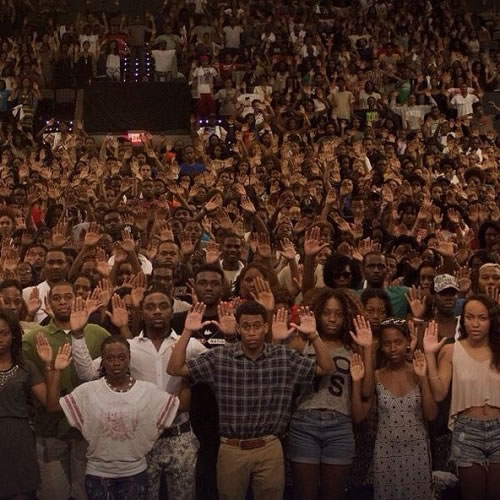
So how are people transformed? Research shows that 79% of activists in the United States report becoming engaged through a civic organization. Every day, thousands of civic organizations across the country, from the NAACP to the Tea Party, work to transform people into activists to win the victories they want.
Yet many of these organizations are still unsure of the best way to build the kind of long-term activist base needed in Ferguson. Many organizations know how to craft messages or leverage big data to find people who will show up for a rally or one event. Few organizations know how to take the people who show up, and transform some of them into citizen leaders who will become the infrastructure that harnesses energy from a week of protest into real change.
I spent two years comparing organizations with strong records of ongoing activism to those with weaker records to try to understand what they do differently. I found that it comes down to their investment in building the motivation, knowledge, and skills of their members. Turning protest into power begins with creating opportunities for people like the residents of Ferguson to exercise their own leadership.
Consider Priscilla, a young organizer working in the rural South to engage people around shutting down coal. When she first started organizing, Priscilla spent all of her time finding people who would show up for town halls, public meetings, and press events. She devoted hours to writing catchy messages and scripts that would get people’s attention, and asked her volunteers, mostly older retirees, to read these routinized scripts into the voicemail of a long list of phone numbers.
After several months of this work, Priscilla was exhausted. She wanted something different. An experienced organizer told her to invest time in developing the leadership of a cadre of volunteers, instead of spending all her time trying to get people to show up to events. Others scoffed at this advice: volunteers don’t want to take on leadership, they said. They want to take action that is easy, makes them feel good, and doesn’t take any time.

Priscilla decided to give it a try. She reached out to a group of likely volunteers to ask them to coffee. She began to get to know them as people. When some agreed to volunteer, she sat them down and explained the larger strategy behind the town hall meeting they were planning, instead of handing them a long list of phone numbers to call. Then, she asked the volunteers what piece of the planning they wanted to be responsible for.
Priscilla started spending her time training and supporting these volunteers in the tasks they’d chosen to oversee. With her help, these volunteers developed their own strategies for getting media for the event, identifying a program of speakers, and leveraging their own social networks to generate turnout. When the big day arrived, more people showed up than Priscilla would have been able to get on her own. More importantly, after the event was over, she also had a group of volunteer leaders exhilarated by their experience running a town hall and eager to do more.
Instead of just getting bodies to fill a room, Priscilla had begun the process of developing leaders. Instead of just coming to one rally, those leaders stayed with and built the campaign that eventually shut down the coal plant in their community.
There are talented organizers on the ground in Ferguson trying to do just what Priscilla did: give residents opportunities to develop the skills and motivation they need to make the change they want. Only by developing those kinds of leaders will organizations in Ferguson develop the infrastructure they need to turn the protest into real power for the residents who feel disconnected from it now.
When Alexis de Tocqueville observed America in the 1830s, he famously wrote that civic organizations are the backbone of our nation because they act as “schools of democracy,” teaching people how to work collectively with others to advance their interests. De Tocqueville is as right today as he was 174 years ago. We have always known that people power democracy. What protests from Occupy to the Arab Spring to Ferguson are teaching us is that democracy can also power people.
Headline image credit: “Occupy Wall Street” by Darwin Yamamoto. CC BY-NC-ND 2.0 via Flickr
The post Moving from protest to power appeared first on OUPblog.
Blog: Here in the Bonny Glen (Login to Add to MyJacketFlap)
JacketFlap tags: organization, Fun Learning Stuff, chores, Household, D&D, Google Calendar, Add a tag
Last night’s talk on habits seemed to go over very well. I was astonished that we had forty moms in attendance! We set up chairs and blankets in my backyard. Several of you have asked for a write-up of the talk, so I’ll work on that during the week. Thanks so much for your interest!
Playing catchup tonight, so this will be another quick one. I’ve been making my way through Mystie Winckler’s Simplified Organization eCourse (affiliate link, and I think the “backtoschool” discount code still works), and I really enjoyed her video on Google Calendar. Same thing happened with gCal as happened with Evernote when I read Mystie’s Paperless Home Organization book: in both cases I thought I was already using the platform in question in a fairly savvy manner, but Mystie taught me some tricks I didn’t know. In the case of Google Calendar (my lifeline for years now), I already had multiple calendars set up that I toggled on and off for various views: Appointments, Kid Activities (including, this summer, Jane’s work schedule; also includes family birthdays), and a Deadlines calendar I share with Scott. But now I’ve added:
• a Household calendar for tracking my daily chores, the ones assigned to specific days of the week a la Flylady;
• a Readalouds calendar (a brainstorm that came to me after Mystie’s video; I’ve tried many ways of logging our numerous picture book readalouds through the week and I always wind up dropping the ball; we’ll see if this one works );
• and a very simple Zones calendar that displays the Flylady zone of the week. I’ve been using Flylady’s schedule, modified, on and off for some fifteen years now! When I follow it, the housework flows so much more smoothly. Until now I never thought of having a gCal dedicated solely to announcing the week’s zone.
The Household calendar has already proven its merits. I created it over the weekend and made recurring entries (not pegged to a specific time, so they appear in bands of color) for the rotating daily chores. Then, for extra tasks such as the ones associated with hosting a houseful of moms, I assigned times (somewhat arbitrary, but I did find it kept me progressing through the tasks through the day) so that those would show up without the orange background.
I’ve never tried anything like this before—listing the individual chores necessary for a non-routine event—and it worked amazingly well for me. I was able to work through the list in a pretty calm manner, not the frazzled frenzy that is my usual state when preparing for company. ![]()
I didn’t put our regular morning/afternoon/evening chores on this calendar because those are routine now, for the kids and me. This is only for my jobs that come around weekly or less often.
***
I got carried away there and wrote more than I meant to. ![]() I’m thinking about adding yet another gCal for our High Tide studies. I have it marked out in colorful chalk and propped on the mantel where I can see it from my favorite chair, but I think I might enjoy seeing it laid out this way too.
I’m thinking about adding yet another gCal for our High Tide studies. I have it marked out in colorful chalk and propped on the mantel where I can see it from my favorite chair, but I think I might enjoy seeing it laid out this way too.
This morning we returned to our (still new) schedule. We’re having a good time with Latin, brushing up on what we learned last go-round. For some reason Latin brings out the merry in all of us. Rose and Bean and I are back to our Romantic poets, so you know I’m in heaven. We’re reading Lear aloud—Rilla is doing a bang-up job as Cordelia—and today (at long last) Rose and I started Paradise Lost. Beanie and I, meanwhile, are spending a few weeks in the company of my beloved Mr. Twain. She’s knee-deep in Connecticut Yankee at the moment. I need to catch up to her.
Obviously we’re going heavy on Lit at the moment. There are other things afoot, of course. Including a whole lot of D&D character-building among the girls. For Rose’s birthday last week, I gave her a new adventure module with a promise to DM for them. In a momentous gesture, Rilla has been invited by her big sisters to join the game. This necessitated a lot of poring over manuals to find the perfect combination of character race and class. I believe she settled upon half-elf paladin. Backstory in progress. I think Rose may enjoy creating characters and fleshing them out even more than playing the game. A girl after my own heart.
Add a CommentBlog: TWO WRITING TEACHERS (Login to Add to MyJacketFlap)
JacketFlap tags: organization, classroom, management, writing workshop, back to school, furniture, work space, procedures, writing center, Sharpen Your Routines Blog Series, writing workshop routines, Add a tag
Every year, around this time, I start having dreams about setting up my classroom. In the classroom of my dreams, I’m moving around small circular tables, unfurling a brand new rug for the… Continue reading ![]()
Blog: ALSC Blog (Login to Add to MyJacketFlap)
JacketFlap tags: organization, School Library Media Specialist, Slice of Life, What I Wasn't Taught in Library School..., Blogger Stacy Dillon, PLN, #readadv, Add a tag
As summer winds down some public librarians are feeling thankful and school librarians are gearing up. I have spent a considerable amount of time planning my year (and realizing that some of those plans will get sidelined). Each year for the past several school years, I have tried some new organizational methods, but have yet to find something with staying power that smooths transitions and helps me in my day to day life.
I was excited when earlier in the summer #readadv had a chat on this very subject. How do librarians get and stay organized? What is working for other people? The storify for this chat can be found here.
It was interesting because folks definitely seemed to use a variety of tools – demonstrating that no one method works for “all the things”. Being of a certain age myself, I have to say that there is an appeal to some of the analog methods and I am more likely to remember something if I write it down on a post-it than if I type it into my google calendar. Now, don’t get me wrong – I live off my google calendar for the majority of my in the moment time, but when in comes to actual planning, I need something more visual.
Enter bullet journal. Some folks have been talking about this on twitter and in blog posts for a while, and this is the method I have decided to experiment with for my overall planning of the school year. The beauty of this system for me is that it seems infinitely tweakable to allow for my own idiosyncrasies. I can color code, add post-its (and stickers!), dog ear pages, and blend as much of my outside of school life as my teaching life as I see fit.
I will check back in with you all later to see if I can make this one stick!
How do you all keep your library lives organized?
Blog: TWO WRITING TEACHERS (Login to Add to MyJacketFlap)
JacketFlap tags: organization, back to school, routines, meeting area, Sharpen Your Routines Blog Series, Add a tag
Are you looking to make the most out of your classroom's meeting area? Find out how to create and maintain a meeting area that will function as the focal point of your writing workshop. ![]()
Blog: Valerie Storey, Writing at Dava Books (Login to Add to MyJacketFlap)
JacketFlap tags: Writing, Organization, Planning, Add a tag
Although it's been a good month since I moved into my new house, there is still a ton of work to do before we can say it's actually finished, or even completely livable. The main difficulty is finding both the time and the energy after work each day to accomplish everything my imagination envisions. The same holds true for my creative life at the moment. As much as I want to finish my WIPs, start a new art journal, and sew a winter wardrobe, it's not going to happen as quickly or completely as I would like. And that makes me feel . . . unhappy.
Last night I had trouble sleeping while I worried about what seemed like five hundred loose ends--disconnected projects and ideas that only spun into more projects and ideas. We had an unexpected (and what I would normally consider very welcome) New Mexico thunderstorm during the middle of the night, increasing my feelings of nervousness, incompetence, and outright failure. Consequently I woke up with a sore back and neck and the need for a serious re-think, resulting in some frantic morning pages and a list I titled, "What I Want to Do." It included:
- Finish my new screenplay.
- Go back to my screenwriting group.
- Finish the edits on my nonfiction WIP, A Pet Owners Book of Days.
- Draw the illustrations for A Pet Owner's Book of Days.
- Finish the edits on my novel WIP, The Abyssal Plain.
- Get back to working with clay.
- Buy jewelry tools and make jewelry.
- Start a really neat poetry project.
- Read my friends’ manuscripts when they ask for critiquing.
- Stay focused on my day job.
- Finish my new house, as in FINISHED.
- Keep up with the housework in my new house (amazing how fast dust collects).
- Read for fun.
- Sleep.
- Blog.
- Stay current with social media.
- Promote my books.
- Buy a sewing machine and start some sewing projects.
- Sketch more often.
- Sign up for The Sketchbook Project.
Impossible? You bet.
- For my daily writing, edit and concentrate only on The Abyssal Plain.
- For my daily art practice: concentrate only on pictures of dogs, cats, and Barcelona.
- Social media is a reward only after I’ve accomplished a timed amount of work every hour or so.
- Freewriting time is only for blog posts.
- Reading is only at bedtime.
- "Finishing the house" as well as housework is only on the weekends.
To get there I'll have to say no a lot, e.g.:
- No sewing.
- No jewelry.
- No clay.
- No poetry.
- No screenplay.
- No critiquing.
Just looking at these lists makes me feel a lot better; I might even get to sleep tonight! The beauty is that I now feel I have some goals back on track. For instance, finishing The Abyssal Plain edits means I can then move on to marketing the manuscript. Drawing cats and dogs will give me a break from the edits and help me create the illustrations for Pet Owners. And getting the house finished over the weekends means we won't get burn-out. So let it rain, let it pour--I've got it covered.
Blog: Biblio File (Login to Add to MyJacketFlap)
JacketFlap tags: organization, spreadsheets, #readadv, #get organized, Add a tag
I am a complete and utter scatter brain, but I have a lot of responsibility and stuff to do in my professional and personal life. Organization is the only way I stay on top of things and am at all functional.
A few weeks ago, the #readadv chat was on how we stay organized. People were pretty interested in each other's systems and wanted more in-depth info than Twitter really allows. Kelly kicked off some posts here for people to share their systems.
People seemed especially interested in Bullet Journaling, which is my personal system. Here's how I do it. (Followed by why it works for me, and how I organize my reading and blogging, too.)
When I was working and in grad school, I swore by the BusyBodyBook planner, but they no longer make them. I loved the columns for different aspects of my life (work/school/blog/LIFE) and I tried a few other things since then, but nothing that I loved as much. I started doing Bullet Journaling this spring and LOVE IT.
So, if you are unfamiliar with the concept of Bullet Journaling, read all about it here or watch this video.
One of the things I love about this system is that it's very flexible. It's incredibly easy to modify it to fit your needs. I don't like how he does calendars, because I need the visual of a typical calendar, so I printed some out and taped them in:
Also, I need to do a certain amount of pre-planning, so I do a few months at a time, and then have another list for events further out. The calendar print-outs are a free download from the Organised Housewife. I like that they have the to-do list on the side of monthly things. I also have a "master to-do" list for things I'm thinking about (like winter holiday presents I want to make, or very long-range projects that are still percolating, or little things that don't have a definite timeline like scheduling a fall dentist appointment.)
I also use a modified version of this key:
(I found it on Pinterest and it doesn't link to anywhere. Does anyone know who created this key? It's GENIUS and I'd love to give full credit.) The big thing I modify is, much like a c and e in the box for "call"/"email" I have a t for "text" and an r for "review" I especially love the half-filled box for things I worked on, but didn't finish. I do break projects into smaller steps, and do that in my journal, but it some steps just take a really long time. I also use the half-shaded box for things I need feedback on, like I needed to talk to someone, but they weren't in, so I just left them a voice mail. The half box lets me know that I may need to follow-up and try again later, but I don't need to worry about it for awhile.
Here's my page from yesterday:
You'll see some other things I modify on my daily pages. I the bottom I have section called "5 things" where I try to write down 5 good things about the day, every day. This is really helpful in combating some of my own personal negativity. I also track my water intake.
For all of this, I use extra-large Moleskine Cahier with gridded paper The extra-large gives me enough room each day, and the gridded paper just lends it self really well to all my to-do squares. I like the cahier because it has a soft cover, which makes it easier to decorate. I embroidered my current one:
To mark important pages, such as the master list, and the current daily page, I use large colored paperclips, as they're easy to move around and won't rip off in my purse:
I change pen colors every day, so I know if notes were made on the same day, or later. My currently into the Le Pen, because it's a slim line felt-tip that won't leak through a thin Moleskine page and comes in good colors. I also like the Sharpie Fine Point Pen for similar reasons (but it's harder to wash off when you accidentally draw on yourself. Not that I ever do that. Nope. Not me.)
So, this system works for me because it combines everything into one place that I can easily move around with me. My meeting notes are next to my schedule and easy to find again to follow up on. I can easily write down hilarious things my daughter said and other things that happened in a day. I can add in pages for projects or brainstorming that are easily accessible. I like that one days I'm not doing anything, I don't have to make a page--I don't have random blank pages or "wasted" space.I like that I can change it whenever I need or want to. The table of contents at the beginning is so basic, but it works SO WELL. I know some people don't like having to number the pages, but I just do it every time I make a new page--no big deal. I really like the key system because it's neater than crossing something off while still having the same level of satisfaction. It also works really well with the GTD system of time-management (I don't do full GTD, but I do parts of it, including just doing tasks that are under 2 minutes, and breaking down projects into steps and only worrying about the one in front of you.)
I also do Inbox 0 at work. It keeps me from missing important messages and quickly shows me what needs to be done. I don't do this at home.
I also have an entire Pinterest board for this subject, full of ideas and things for planners and organizing (including awesome sticky notes and notebooks).
Now, how do I track my reading and reviewing? Like I mentioned above, I modified the key so there's a symbol for call, email, text, and review. I try to review library books before they're due back and am pretty good about it. I try to review books I own shortly after reading, with less success. I tend not to schedule my reviews or review to a date unless I'm reviewing for someone else (RT Book Reviews and School Library Journal have deadlines, for instance) or a blog tour. Deadlines go on the calendar and get exclamation points on the daily list.
I keep track of my reading in a notebook. I have them dating back to spring of 2006 and printed lists going back to 2003, but wish I had kept track of stuff previous to that! Here's what my notebook looks like:
It's pretty simple. Month, title, author. A check mark once it's been reviewed on the blog, or the review has been linked to on the blog.
To do more in-depth review tracking, I use a Google spreadsheet that I update every few months.
Month and year help me cross-reference with the paper book. You'll see I'm full of typos and shorthand for titles--as long as I know what book I'm referring to, I'm good. Then there's the column I can mark if a review has been written. I have a giant Google doc for reviews. I then edit/update/polish when I paste them into Blogger to preschedule/post. Then I have a notes field, where I can write when things are prescheduled for (if it's further out than the next week or two--I use this a lot with ARCs as I tend to post reviews on pub date or only a day or two before), if it's a review that's posting elsewhere, if it's a committee book so reviews need to be held, or modified, or just not done (depends on the committee regulations/policies), if I have notes on it but no review, etc etc etc. It's pretty basic, but it does what I need it to do. Once a review is posted, I delete that line, so the sheet ONLY tracks outstanding reviews.
Links to Amazon are an affiliate link. You can help support Biblio File by purchasing any item (not just the one linked to!) through these links. Read my full disclosure statement.
Blog: OUPblog (Login to Add to MyJacketFlap)
JacketFlap tags: eero, Social Sciences, *Featured, organizational, Business & Economics, Ann Langley, corporate strategy, Eero Vaara, François Cooren, Haridimos Tsoukas, language and communication at work, processually, tsoukas, vaara, cooren, haridimos, communicational, business, Organization, language, Current Affairs, communication, Add a tag
By François Cooren, Eero Vaara, Ann Langley, and Haridimos Tsoukas
“Communication matters in organizations!”
We all know this catchphrase. Both employees and managers experience problems daily with coordination, and when news (good or bad) is released about their organization. There is, however, a different way of studying communication at work, a way that does not merely reduce it to the transfer of information, but also explores its constitutive aspects: how communicative events literally constitute what organizations are all about.
Connect communication to the very processes, activities, and practices that constitute organizations or organizational phenomena. This echoes what Phillips and Lawrence (2012) recently labeled “the turn to work” in organization studies. These authors referred to notions such as “identity work,” “institutional work,” and “boundary work” as part of a trend in which scholars have been highlighting “the role of actors in socially constructing elements of work and organizations that were previously seen as either ‘natural’ or beyond the control of individual actors.”
Phenomena such as identity, routines, boundaries, or organizations themselves are thus seen as communicative processes, which means that ongoing “work” is implicated in the construction, maintenance, and adaptation of organizational identities, boundaries, and operations. Communication is the essential way through which much of this “work” takes place, whether or not conscious intentions lie behind it.
Depart from abstract and static considerations to concentrate on communicational activities and practices that constitute the daily life of organizations, or capture the ways in which they change over time. These types of study focus on cultural, artifactual, ideological, or technological aspects of work, and systematically scrutinize and highlight the communicational dimension of these activities, whether from a theoretical or empirical perspective.
The study of language and communication at work could prove to be a fruitful way to study organizational life in all its aspects (meetings, speeches, routines, operations, expeditions, etc.). Organizations should not only be viewed as ‘things made’ but also as what Hernes (2007) calls “processes in the making,” whether we want to study reproduction, development, or change. If analyzing and conceiving of processes is indeed a difficult thing to do, it is, we believe, the price we need to pay to study organizational matters in a very concrete and incarnated manner.

If organizations are dynamically constituted, we thus need to start thinking processually, that is, we need to invent new ways of studying and conceiving of these “works in process” we call companies, firms, businesses, institutions, NGOs, and associations. In keeping with Derrida’s (often misunderstood) concept of differance, this processual way of thinking leads us to study any organizational course, sequence, or practice in terms of both its passive and active dimensions, i.e. in terms of what leads it to be what it is, but also in terms of what it produces, enacts, and contributes. Studying processes indeed means that there cannot be an absolute point of origin and that we need, as analysts, to always pay attention to what is ongoing.
Methodologically speaking, this could have serious consequences, as thinking and analyzing the organizational world processually will also lead us to rely more and more on actual recordings of activities, conversations, and practices. Although interviews certainly remain relevant ways to access what is taking place in organizational settings, they seem poorly equipped to study processes per se, as they rely on post-hoc reconstructions that cannot always do justice to what really happens ‘in the making’ (except, of course, if the interviews themselves are analyzed processually). Whether video or audio recordings, the detailed study of communication at work seems to require that we “pay our due” to the phenomena themselves.
But studying processually means that we also have to develop tools and methodologies that allow us to not only make some gains in terms of details, but also in terms of longitudinality. The detailed study of processes indeed implies, by definition, that we follow them through time and space, a methodological requirement that often seems hard to reconcile with the thoroughness of detailed analyses. It is, we believe, in this uncomfortable tension that the future of process studies might lay.
François Cooren is Professor and Chair of the Department of Communication at Université de Montréal; Eero Vaara is Professor of Management and Organization at Hanken School of Economics, Helsinki; Ann Langley is Professor of Management at HEC Montréal; and Haridimos Tsoukas is Professor of Strategic Management and Professor of Organization Studies at University of Cyprus, and at Warwick Business School. Their book Language and Communication at Work. Discourse, Narrativity and Organizing was published May, 2014.
Subscribe to the OUPblog via email or RSS.
Subscribe to only business articles on the OUPblog via email or RSS.
Image Credit: Businesspeople at boardroom table. © monkeybusinessimages via iStock Photo.
The post The role of communication at work appeared first on OUPblog.
Blog: TWO WRITING TEACHERS (Login to Add to MyJacketFlap)
JacketFlap tags: organization, professional development, classroom, writing workshop, lucy calkins, units of study, lesson plans, minilesson, tcrwp, balanced literacy, independent writing, Add a tag
As the school year comes to a close, many of the schools I work with are launching into a week or so of in-service, summer institutes, and other professional development. It’s “curriculum season”… Continue reading ![]()
View Next 25 Posts




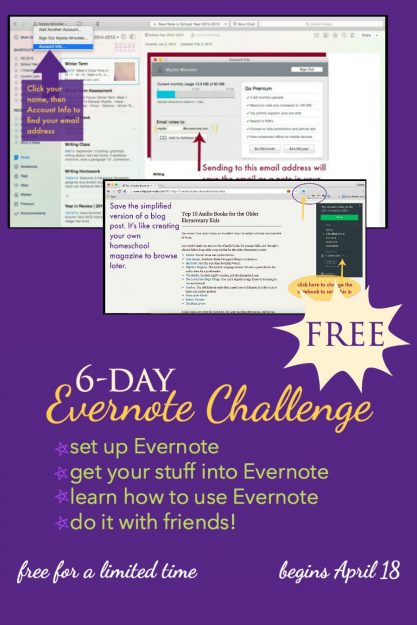


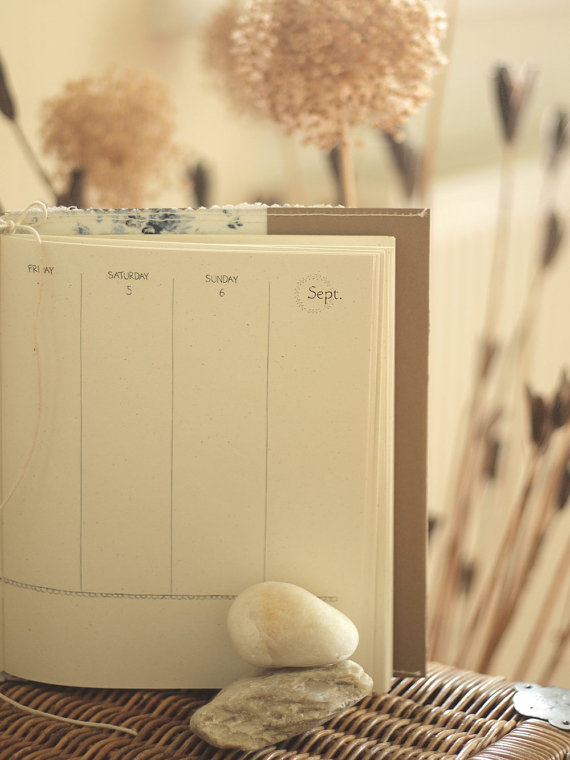



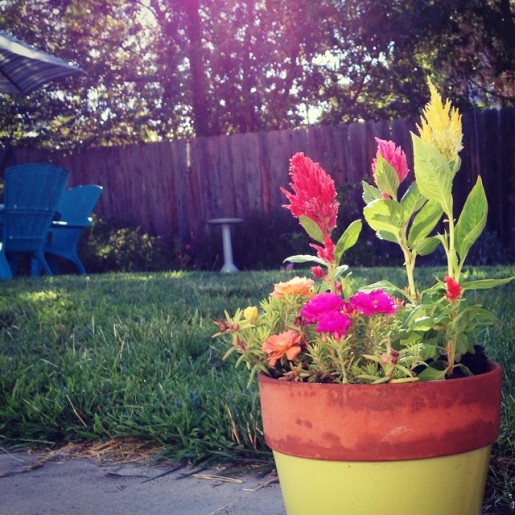
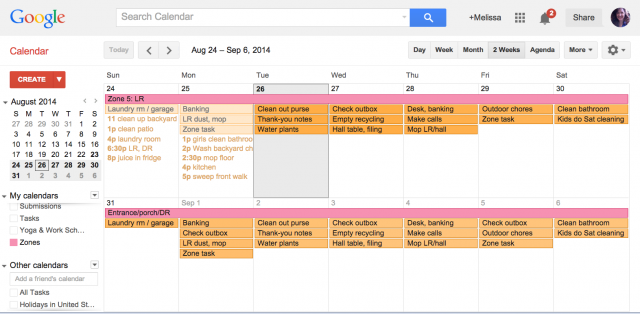




a.jpg)

